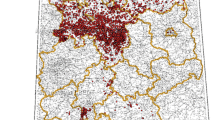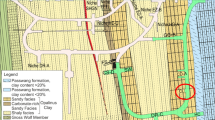Abstract
The geological sequestration (geosequestration) of carbon dioxide (CO2) is a mitigation method for reducing greenhouse gas emission into the atmosphere. The security and safety of CO2 geosequestration are strongly dependent on the mechanical stability of the caprock overlying the reservoir. Underground injection of CO2 increases the pore pressure and thus decreases the effective stress. It may lead to caprock failure, as well as the subsequent leakage of sequestered CO2. In particular, geothermal exploitation and the underground disposal of hazardous liquid wastes have demonstrated a risk of induced seismicity. We performed an uncertainty analysis using a novel response surface methodology and a two-step statistical experimental design, evaluated the statistical significance of operator choices and subsurface uncertainties to caprock integrity, and quantified the moment magnitude of the induced seismicity. Furthermore, the optimal combination (i.e., the worst-case scenario) with the desired properties was forecast. A series of numerical experiments was well designed, and 130 combinations were statistically determined. Based on the results from the analysis of variance for the response surface quadratic model, the impact indicators were presented in histograms according to their significances to the Coulomb failure stress and moment magnitude of the induced seismicity. Lastly, the values of the selected independent impact indicators were predicted to obtain optimal compositions for object function of both Coulomb failure stress and moment magnitude, and the desired properties were being picked out. The optimal combinations had desirability values of 1.000, demonstrating the fitness of the selected statistical models in analyzing the experimental data.









Similar content being viewed by others
References
Aruffo C, Rodriguez-Herrera A, Tenthorey E, Krzikalla F, Minton J, Henk A (2014) Geomechanical modelling to assess fault integrity at the CO2CRC Otway project, Australia. Aust J Earth Sci 61:987–1001
Aslan N, Cebeci Y (2007) Application of Box–Behnken design and response surface methodology for modeling of some Turkish coals. Fuel 86:90–97. doi:10.1016/j.fuel.2006.06.010
Bachu S (2000) Sequestration of CO2 in geological media: criteria and approach for site selection in response to climate change. Energy Convers Mgmt 41:953–970
Biot MA (1956) Theory of propagation of elastic waves in a fluid-saturated porous solid. I. Low-frequency range. J Acoust Soc Am 28:168–178
Box GEP, Behnken DW (1960) Some new three level designs for the study of quantitative variables. Technometrics 2:455–475. doi:10.1080/00401706.1960.10489912
Box GE, Hunter JS (1957) Multi-factor experimental designs for exploring response surfaces. Ann Math Stat 195–241
Cappa F, Rutqvist J (2011) Modeling of coupled deformation and permeability evolution during fault reactivation induced by deep underground injection of CO2. Int J Greenh Gas Control 5:336–346
Coussy O (2004) Poromechanics. Wiley, New York
Dempsey D, Kelkar S, Pawar R, Keating E, Coblentz D (2014) Modeling caprock bending stresses and their potential for induced seismicity during CO2 injection. Int J Greenh Gas Control 22:223–236. doi:10.1016/j.ijggc.2014.01.005
Deng H, Stauffer PH, Dai Z, Jiao Z, Surdam RC (2012) Simulation of industrial-scale CO2 storage: multi-scale heterogeneity and its impacts on storage capacity, injectivity and leakage. Int J Greenh Gas Control 10:397–418. doi:10.1016/j.ijggc.2012.07.003
Dethlefsen F, Haase C, Ebert M, Dahmke A (2011) Uncertainties of geochemical modeling during CO2 sequestration applying batch equilibrium calculations. Environ Earth Sci 65:1105–1117. doi:10.1007/s12665-011-1360-x
Fei W, Li Q, Wei X, Song R, Jing M, Li X (2015) Interaction analysis for CO2 geological storage and underground coal mining in Ordos Basin, China. Eng Geo 196:194–209. doi:10.1016/j.enggeo.2015.07.017
Ferreira SL et al (2007) Box–Behnken design: an alternative for the optimization of analytical methods. Anal Chim Acta 597:179–186. doi:10.1016/j.aca.2007.07.011
Gysi AP, Stefánsson A (2012) Experiments and geochemical modeling of CO2 sequestration during hydrothermal basalt alteration. Chem Geol 306–307:10–28. doi:10.1016/j.chemgeo.2012.02.016
Hosein R, Alshakh S (2013) CO2 sequestration in saline water: an integral part of CO2 sequestration in a geologic formation. Pet Sci Technol 31:2534–2540. doi:10.1080/10916466.2011.574181
IPCC (2005) IPCC special report on carbon dioxide capture and storage. Cambridge University Press, Cambridge
Iversen GR, Norpoth H (1987) Analysis of variance, vol 1. Sage, London
Jaeger JC, Cook NG, Zimmerman R (2009) Fundamentals of rock mechanics. Wiley, New York
Jeannin L, Mainguy M, Masson R, Vidal-Gilbert S (2007) Accelerating the convergence of coupled geomechanical-reservoir simulations. Int J Numer Anal Meth Geomech 31:1163–1181. doi:10.1002/nag.576
Karimnezhad M, Jalalifar H, Kamari M (2014) Investigation of caprock integrity for CO2 sequestration in an oil reservoir using a numerical method. J Nat Gas Sci Eng 21:1127–1137. doi:10.1016/j.jngse.2014.10.031
Khuri AI, Mukhopadhyay S (2010) Response surface methodology. Wiley Interdiscip Rev Comput Stat 2:128–149. doi:10.1002/wics.73
Lary LD et al. (2015) Quantitative risk assessment in the early stages of a CO2 geological storage project: implementation of a practical approach in an uncertain context. Greenh Gases Sci Technol 5:50–63. doi:10.1002/ghg.1447
Lei X, Ma S (2013) A detailed view of the injection-induced seismicity in a natural gas reservoir in Zigong, southwestern Sichuan Basin, China. J Geophys Res Solid Earth 118:4296–4311
Li Q, Liu G, Liu X, Li X (2013) Application of a health, safety, and environmental screening and ranking framework to the Shenhua CCS project. Int J Greenh Gas Control 17:504–514. doi:10.1016/j.ijggc.2013.06.005
Li Q, Fei W, Liu X, Wei X, Jing M, Li X (2014a) Challenging combination of CO2 geological storage and coal mining in the Ordos Basin, China. Greenh Gases Sci Technol 4:452–467. doi:10.1002/ghg.1408
Li Q, Liu G, Liu X (2014b) Development of management information system of global acid gas injection projects. In: Wu Y, Carroll JC, Li Q (eds) Gas injection for disposal and enhanced recovery. Advances in natural gas engineering. Wiley, New York, pp 243–254. doi:10.1002/9781118938607.ch13
Li Q, Wei Y-N, Liu G, Lin Q (2014c) Combination of CO2 geological storage with deep saline water recovery in western China: insights from numerical analyses. Appl Energy 116:101–110. doi:10.1016/j.apenergy.2013.11.050
Liu L-C, Wu G (2015) Assessment of energy supply vulnerability between China and USA. Nat Hazards 75:127–138. doi:10.1007/s11069-014-1071-1
Liu C, Zhao H, Sun Y (2009) Tectonic background of Ordos Basin and its controlling role for basin evolution and energy mineral deposits. Energy Explor Exploit 27:15–27
Mathias SA, Hardisty PE, Trudell MR, Zimmerman RW (2009) Screening and selection of sites for CO2 sequestration based on pressure buildup. Int J Greenh Gas Control 3:577–585
Myers RH, Montgomery DC, Anderson-Cook CM (2009) Response surface methodology: process and product optimization using designed experiments, vol 705. Wiley, New York
Nuzzo RG (2014) Scientific method: statistical errors. Nature 506:150–152
O’Dell PM, Lindsey KC (2010) Uncertainty management in a major CO2 EOR project. Abu Dhabi International Petroleum Exhibition and Conference. Society of Petroleum Engineers, Abu Dhabi, UAE. doi:10.2118/137998-MS
Rohmer J (2014) Induced seismicity of a normal blind undetected reservoir-bounding fault influenced by dissymmetric fractured damage zones. Geophys J Int 197:636–641. doi:10.1093/gji/ggu018
Rohmer J et al (2014) Improving our knowledge on the hydro-chemo-mechanical behaviour of fault zones in the context of CO2 geological storage. Energy Procedia 63:3371–3378. doi:10.1016/j.egypro.2014.11.366
Rutqvist J (2012) The geomechanics of CO2 storage in deep sedimentary formations. Geotech Geol Eng 30:525–551. doi:10.1007/s10706-011-9491-0
Rutqvist J, Wu YS, Tsang CF, Bodvarsson G (2002) A modeling approach for analysis of coupled multiphase fluid flow, heat transfer, and deformation in fractured porous rock. Int J Rock Mech Min Sci 39:429–442
Seebeck H, Tenthorey E, Consoli C, Nicol A (2015) Polygonal faulting and seal integrity in the Bonaparte Basin, Australia. Mar Pet Geol 60:120–135. doi:10.1016/j.marpetgeo.2014.10.012
Shen X (2010) Examples and applications of ABAQUS in energy engineering. China Machine Press, Beijing
Shukla R, Ranjith P, Haque A, Choi X (2010) A review of studies on CO2 sequestration and caprock integrity. Fuel 89:2651–2664. doi:10.1016/j.fuel.2010.05.012
Song J, Zhang D (2013) Comprehensive review of caprock-sealing mechanisms for geologic carbon sequestration. Environ Sci Technol 47:9–22. doi:10.1021/es301610p
Tenthorey E, Dance T, Cinar Y, Ennis-King J, Strand J (2014) Fault modelling and geomechanical integrity associated with the CO2CRC Otway 2C injection experiment. Int J Greenh Gas Control 30:72–85. doi:10.1016/j.ijggc.2014.08.021
Vidal-Gilbert S, Nauroy J-F, Brosse E (2009) 3d geomechanical modelling for CO2 geologic storage in the Dogger carbonates of the Paris Basin. Int J Greenh Gas Control 3:288–299. doi:10.1016/j.ijggc.2008.10.004
Vilarrasa V (2014) Impact of CO2 injection through horizontal and vertical wells on the caprock mechanical stability. Int J Rock Mech Min Sci 66:151–159. doi:10.1016/j.ijrmms.2014.01.001
Wei XC, Li Q, Li X-Y, Sun Y-K, Liu XH (2015) Uncertainty analysis of impact indicators for the integrity of combined caprock during CO2 geosequestration. Eng Geol 196:37–46. doi:10.1016/j.enggeo.2015.06.023
Xing H, Liu Y, Gao J, Chen S (2015) Recent development in numerical simulation of enhanced geothermal reservoirs. J Earth Sci 26:28–36
Yang D, Zeng R, Zhang Y, Wang Z, Wang S, Jin C (2012) Numerical simulation of multiphase flows of CO2 storage in saline aquifers in Daqingzijing oilfield, China. Clean Technol Environ Policy 14:609–618. doi:10.1007/s10098-011-0420-y
Zhou X, Burbey TJ (2014) Pore-pressure response to sudden fault slip for three typical faulting regimes. Bull Seismol Soc Am 104:793–808
Zhou R, Huang L, Rutledge J (2010) Microseismic event location for monitoring CO2 injection using double-difference tomography. Lead Edge 29:208–214. doi:10.1190/1.3304826
Zoback MD, Gorelick SM (2012) Earthquake triggering and large-scale geologic storage of carbon dioxide. Proc Natl Acad Sci USA 109:10164–10168. doi:10.1073/pnas.1202473109
Acknowledgments
This work was mainly supported by the National Natural Science Foundation of China (NSFC) under Grant No. 41274111. We would also like to thank the financial support provided by the National Department Public Benefit Research Foundation of MLR, China (Grant No. 201211063-4-1), and the China National Key Technology R&D Program (Grant No. 2012BAC24B05).
Author information
Authors and Affiliations
Corresponding author
Electronic supplementary material
Below is the link to the electronic supplementary material.
Rights and permissions
About this article
Cite this article
Wei, X., Li, Q., Li, X. et al. Impact indicators for caprock integrity and induced seismicity in CO2 geosequestration: insights from uncertainty analyses. Nat Hazards 81, 1–21 (2016). https://doi.org/10.1007/s11069-015-2063-5
Received:
Accepted:
Published:
Issue Date:
DOI: https://doi.org/10.1007/s11069-015-2063-5




